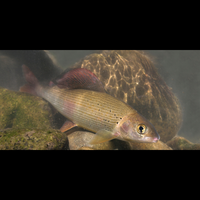Thymallus Thymallus.
Thymallus thymallus belongs to the family Salmonidae and the genus Thymallus. First described by Linnaeus in 1758, it is the most widespread and well-known grayling species in Europe. It is genetically and ecologically distinct from other grayling species found in more isolated regions.
Recent genetic studies have identified six distinct evolutionary lineages within Thymallus thymallus:
- Northern Alps (Danube)
- Southern Alps (Danube)
- Western Balkan (Danube)
- Mixed Central Europe (Rhone, Rhine, Elbe, and some rivers flowing into the Baltic Sea)
- Scandinavian (Scandinavia)
- North-Eastern Europe (rivers flowing into the Caspian Sea)
These lineages reflect postglacial recolonization patterns and have implications for conservation and management.
Physical Characteristics.
The European grayling is noted for:
- A slim, laterally compressed body
- A strikingly large, sail-like dorsal fin in males, often marked with vibrant colors
- Silver to bluish body coloration with small dark spots
- An average adult size of 30–40 cm, with larger specimens reaching over 50 cm
Its vivid dorsal fin and graceful movements have earned it a reputation as one of Europe’s most beautiful freshwater fish.
Habitat and Distribution.
Thymallus thymallus is found throughout much of Europe, from the United Kingdom and France in the west to the Ural Mountains in the east. It inhabits cold, well-oxygenated rivers and lakes, often preferring riffles and fast-flowing segments with gravel or sandy bottoms.
Ecology and Life History.
European grayling are omnivorous, feeding primarily on aquatic insects, crustaceans, and occasionally small fish. Spawning occurs in spring, typically in shallow gravel beds where females lay adhesive eggs. Grayling do not migrate long distances and tend to remain within defined river sections.
They are social fish, often forming loose shoals outside the breeding season.
Conservation Status and Threats.
While not globally endangered, local populations of Thymallus thymallus are declining due to:
- River regulation and habitat modification
- Pollution and agricultural runoff
- Overfishing and poaching
- Competition and hybridization with non-native species
Conservation efforts focus on habitat protection, water quality improvement, and controlled fishing practices.
Cultural and Scientific Significance.
European grayling hold cultural importance in traditional fly fishing and are a symbol of healthy river ecosystems. Scientifically, they are studied as indicators of environmental change and are key species in freshwater biodiversity assessments.


.jpg/picture-200?_=19299eae4a8)
.jpg/picture-200?_=1912de74180)